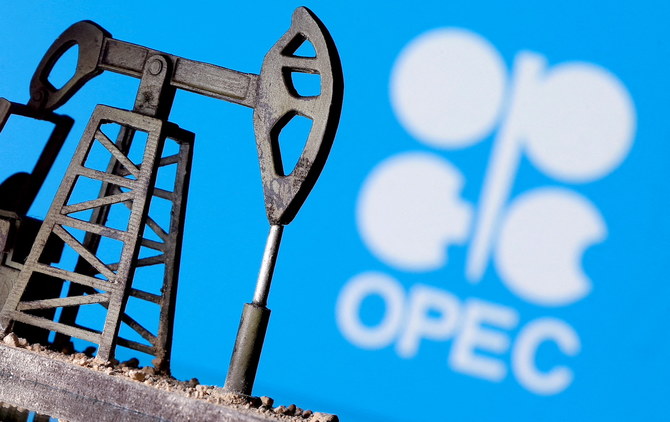
- ARAB NEWS
- 18 May 2024

Oil prices are determined by many factors such as OPEC+ production, non-OPEC+ production, OECD and non-OECD demand, inventories on hand in various parts of the world, excess oil capacity, what is happening in financial markets, demand in various oil consuming markets and hundreds of other variables.
But for the foreseeable future something is going to dominate how these other things are decided upon: Increased international insecurity and risk and it is looking to be a very uncertain and risky time indeed.
What is driving this increased sense of risk for consumers and producers? There is a brutal war in Ukraine that has galvanized many leaders in the world to turn on Russia. New and complex targeted sanctions that have brought turmoil to financial and energy markets. Some of the largest companies in the world are bailing out of one of the largest oil producers and exporters in the world: Russia. BP and Equinor have decided to leave and others will follow. Many pension funds and other big investors in Russia are divesting. The Russian ruble has collapsed and tough sanctions are being placed on the Russian leadership, the Russian central bank, Russian trade and investment, and the wealthy and powerful in Russia and related to Russia.
Russia President Vladimir Putin ordered his nuclear forces to alert — if you want to rattle financial and energy markets do something like that.
Sweden and Finland are thinking of joining NATO, which is their right, and in this environment caused by the Russian moves on Ukraine one can certainly understand these views. Ukraine has applied for membership in the EU and it would not be surprising if they also applied for membership in NATO. These moves and others will anger the Russian leadership further because one of their alleged reasons for the war is that they feel threatened by NATO at their doorstep. NATO has been beside them with EU and NATO members Estonia, Lithuania, Latvia, and Poland bordering Russia. Kaliningrad is a part of Russia inside of the EU that is beside Lithuania and Poland.
To many, these developments seem to have developed overnight, however this is a slow-motion train wreck that has been in process for many decades. Putin sees the fall of the USSR as the defining moment of his life; he resents it and would like to turn it around.
This war is in many ways the continuation of the extraordinarily complex “Cold War,” which brought hot and cold proxy wars all over the globe.
Dr. Paul J. Sullivan
Many people see his attack on Ukraine as his rebuilding of the Soviet Union, or at least a new Russian empire. NATO and others do not want that and would instead prefer to develop more democracies and counterweights to what they see as an increasingly aggressive Russia.
This war is in many ways the continuation of the extraordinarily complex “Cold War,” which brought hot and cold proxy wars all over the globe. Ukraine is the most recent example of this battle of ideologies, wits, and systems. The “Cold War” never ended.
Add energy to the mix of stresses and strains and the picture gets more complex and dangerous. The US warned the Europeans as far back as the time of John F. Kennedy to not become beholden to energy from the then Soviet Union but the Europeans persisted in tying themselves via massive pipelines and other energy systems to the Soviet Union.
On the demise of the Soviet Union those pipelines and energy ties between Europe and Russia continued and were strengthened with Nordstream I and Nordstream II and other oil and gas pipeline systems that Russia and the Europeans agreed to.
Europe now relies massively on Russian energy exports and Russia relies massively on Europe to be its most important energy consumer. The tensions between Europe, now the EU, and Russia have never been this bad yet Europe cannot extract itself from the energy grip of Russia. Russia cannot easily develop alternative markets for its oil and gas.
The world is at an inflection point of international tensions. Oil markets are world markets. When there is turmoil in any important oil area of the world, such as the Middle East and Russia, the oil and other markets get in a boil.
If the war gets worse and spreads, then the turmoil will get worse and spread. In addition, note that the military, diplomatic, economic, and informational turmoil in the Russia-EU region spread quite quickly to the rest of the world. Look at what happened to stock and bond markets and the price of gold and other “safety” investments.
The upcoming OPEC+ meeting will have to consider these historical and present trends — the global turmoil, the increased stresses and strains at many levels — and then decide what to do. There is uncertainty about uncertainty and this is not an easy time to make big decisions. It might be best if they delayed any decisions on output to see where this all goes. It might be wise to keep the doors open to emergency meetings at a moment’s notice … just in case. However, the worst thing they could do in this environment is to add more jolts and shocks. I hope reason and common sense prevail in all of this.
• Dr. Paul Sullivan is a senior research associate at KFCRIS and non-resident fellow, Global Energy Center, Atlantic Council.